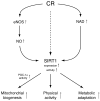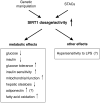SIRT1 and caloric restriction: an insight into possible trade-offs between robustness and frailty
- PMID: 19474721
- PMCID: PMC2734391
- DOI: 10.1097/MCO.0b013e32832c932d
SIRT1 and caloric restriction: an insight into possible trade-offs between robustness and frailty
Abstract
Purpose of review: This review aims to summarize the importance of the mammalian nicotinamide adenine dinucleotide (NAD)-dependent deacetylase SIRT1 as a critical mediator that coordinates metabolic responses to caloric restriction and the recent progress in the development of SIRT1-targeted caloric restriction mimetics. It also discusses possible trade-offs between robustness and frailty in caloric restriction and the applicability of caloric restriction or SIRT1-targeted caloric restriction mimetics to humans.
Recent findings: Loss-of-function and gain-of-function mouse studies have provided genetic evidence that SIRT1 is a key mediator that orchestrates the physiological response to caloric restriction. SIRT1-activating compounds function as potential caloric restriction mimetics, at least in part, through the activation of SIRT1 in vivo.
Summary: Increasing SIRT1 dosage/activity is effective to provide significant protection from high-fat diet-induced metabolic complications, suggesting that SIRT1 activation likely promotes robustness in the regulation of metabolism. However, caloric restriction itself and caloric restriction mimicry through systemic SIRT1 activation might also generate frailty in response to unexpected environmental stimuli, such as bacterial and viral infections. It will be of great importance to understand the principles of systemic robustness and its spatial and temporal dynamics for the regulation of aging and longevity in mammals in order to achieve an optimal balance between robustness and frailty in our complex physiological system.
Figures



References
-
- McCay CM, Crowell MF, Maynard LA. The effect of retarded growth upon the length of life span and upon the ultimate body size. J Nutr. 1935;10:63–79. - PubMed
-
- Jiang JC, Jaruga E, Repnevskaya MV, Jazwinski SM. An intervention resembling caloric restriction prolongs life span and retards aging in yeast. Faseb J. 2000;14:2135–7. - PubMed
-
- Lin SJ, Defossez PA, Guarente L. Life span extension by calorie restriction in S. cerevisiae requires NAD and SIR2. Science. 2000;289:2126–2128. - PubMed
-
- Klass MR. Aging in the nematode Caenorhabditis elegans: major biological and environmental factors influencing life span. Mech Ageing Dev. 1977;6:413–429. - PubMed
Publication types
MeSH terms
Substances
Grants and funding
LinkOut - more resources
Full Text Sources
Other Literature Sources
Medical
Research Materials

